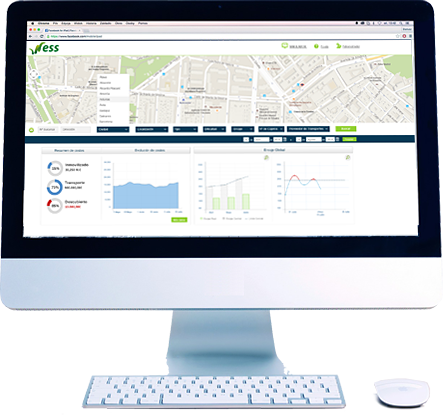-
 CASH MANAGEMENT IN BANK BRANCHESNESS guarantees cash is available at any withdrawal and deposit cash point, saving unnecessary costs due to a lack of adequate planning.
CASH MANAGEMENT IN BANK BRANCHESNESS guarantees cash is available at any withdrawal and deposit cash point, saving unnecessary costs due to a lack of adequate planning.

Cash management is becoming an increasing issue for financial institutions. Solutions and methods for cash distribution and maintenance need to be adapted to the clients’ needs in order to guarantee a good service. NESS adjusts to requirements from different banking institutions and to the consumers spending patterns to guarantee cash resources are available at any withdrawal and deposit cash point (branches, ATMs, cash distribution centres…), saving unnecessary costs due to a lack of adequate planning.
What is NESS?
NESS (Necesidades de Efectivo en Sucursales bancarias —Cash Management in Bank Branches—) is the IIC solution for optimization of the Banking services devoted to manage cash resources in the financial institutions. NESS minimizes costs associated to cash management derived from money processing, immobilization or armoured car transportation, among others. Likewise, NESS guarantees cash is available at the different cash points (counters, ATMs…) in order to fully satisfy demand from clients.
NESS works as a prescriptive analytics system, generating daily planning on the cash levels that should be kept at any cash point every day, and on the efficient transport for collection and delivery of the cash needed at every branch. This planning is undertaken considering all costs and restrictions of the cash management system (reserve limits, security margins, storage capacity of the cash point, sectoring…). As a result, planning offered by NESS reduces costs of the system to a minimum while servicing clients properly.
How does NESS work?
The key for success of NESS is the data technology it is based on. For every cash point, NESS performs an advanced statistical analysis using historical data of demand for cash, also dealing with national holidays, long weekends, time of the year, weekly and monthly cycles, etc., with the aim to predict the demand that might be expected at the cash point over the next few weeks, among others.
This individualized analysis for every cash point allows us to collect and handle several dynamics, such as for branches located in a specific shopping area or ATMs that are close to a University campus. NESS can also measure the degree of variability of its own estimations, hence generating detailed information on the cash points or the days that are most liable to changes related to the demand for cash.
NESS makes use of this predictive information applying techniques of optimization under uncertainty to generate a planning scheme. This process includes restrictions that might be on the banking institution system, and the price of the components used, which results in a low cost realist planning that guarantees servicing the client.
Benefits
NESS advantages are:
Costs savings
Costs savings in every component of the institution’s cash management system (cash immobilization, armoured car transportation routes, money processing…).
Fulfilment of the bank policies
Fulfilment of the bank policies, ensuring they are followed at every branch (security margins, reserve limits set for branches, etc.).

Guaranteed service to the client
Guaranteed service to the client (cash levels, deposits, over-the-counter withdrawal…).
Automatic decision making process
Automatic decision making process, saving time to technicians devoted to planning (daily replanning of allowances for impairment, optimised estimation of the amounts that must be transported…).
Acceptable risk levels
Acceptable risk levels defined by the banking institution itself.
Guaranteed efficiency
Advanced techniques of demand prediction and costs optimization under uncertainty confer NESS reliable statistical guarantees of effectiveness. This fact, along with the global vision of the NESS cash system, enhances significantly decentralised traditional management, by which every branch makes its own decisions and manages the cash they are operating with according to their own experience.
Moreover, NESS may be configured in order to ensure optimal levels to service clients, adjusting parameters that regulate possible savings and stock-out risk for a cash point. Thus, it is the banking institution the one who will determine the risk levels that are acceptable. NESS can be adapted to these levels in order to achieve the minimum costs and avoid the risk threshold set.
Why invest in NESS?
Some of NESS features are:
- It provides a clear ROI, as it reduces costs of a management system that is inherent to the banking institutions.
- High degree of adaptability to the distinctive features of the financial institution, since it adjusts to its policies, restrictions, costs and features of the cash points.
- It generates daily planning, and therefore allows servicing the client properly.
Solutions implemented so far
NESS has been developed at the IIC using our own technology and in close collaboration with one of the most important financial institutions in Spain, established in Europe and America. Due to this fact, NESS has been adapted to the current situation of cash management, with a savings potential of up to 14% of the total cost according to the experience performed so far, ensuring very low levels of overdrafts in cash points as well.
NESS provides a clear role, because it reduces costs of a management system inherent to banks.

